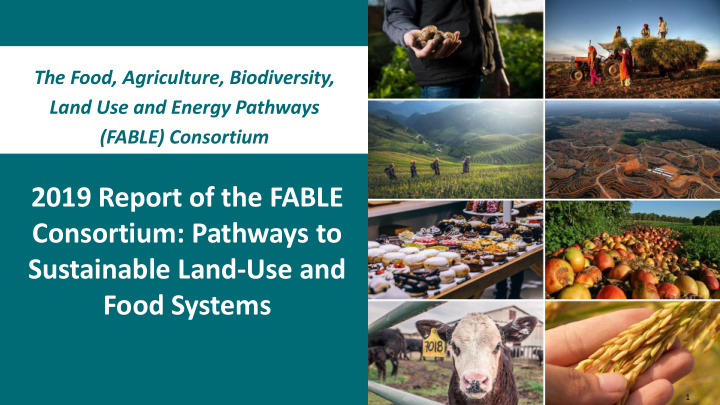



The Food, Agriculture, Biodiversity, Land Use and Energy Pathways (FABLE) Consortium 2019 Report of the FABLE Consortium: Pathways to Sustainable Land-Use and Food Systems 0 1
The F ood, A griculture, B iodiversity, L and Use, and E nergy (FABLE) Pathways Consortium 2
The FABLE Consortium A collaborative initiative operating as part of the Food and Land-Use Coalition (FOLU) Objective: to understand how countries can transition towards sustainable land-use and food systems and collectively meet the Sustainable Development Goals and objectives of the Paris Agreement The Fable Consortium: Independent research teams from 18 countries, including the European Union Led by IIASA and SDSN Working closely with EAT, the Potsdam Institute for Climate Impact Research (PIK), and many other institutions Members provide training & technical support to each other and collaborate to fill knowledge gaps in building FABLE pathways 3
FABLE Country Teams Argentina Australia Brazil Canada China Colombia Ethiopia European Union Finland India Indonesia Malaysia Mexico Russian Federation Rwanda Sweden United Kingdom United States South Africa had recently joined the Consortium but did not contribute to the FABLE report 2019 4
An integrated framework for action The FABLE Consortium has identified three pillars for designing integrated strategies to achieve sustainable land-use and food systems. • Each pillar requires profound changes from business-as-usual practices. • Each is equally important, and all are interdependent and synergistic. • They should be tailored to each country, take account of local constraints, and be complemented with local priorities. Source: Schmid-Traub et al., Nature (2019) 5
Targets for sustainable land-use and food systems Proposed global targets for sustainable land use and food systems are based on : Focus on mid-century Existing international commitments Latest science Scalable from local to global 6
Pathways as a method for problem solving The FABLE Consortium focus on strengthening country teams’ capacity to advise their governments on the design and implementation of long-term strategies towards sustainable land-use. Major steps in the FABLE method for developing national pathways 1. Capacity development and sharing of best practice for data management and modeling of the three pillars. 2. Development of mid-century national pathways that can collectively achieve the jointly agreed global targets and have consistent trade assumptions. 3. Analysis of national policy options and support to national and international policy processes. 7
Scenathon [ sɪˈnɑːθɒn ] Scenario + Marathon A SCENATHON is a time restricted scenario exercise building solution pathways. 8
Linker machine Trade consistency Country B Country A Bilateral coordination
Key Findings of the FABLE 2019 Report 13
Most global targets can be reached by 2050 4 out of 5 targets can be reached: Average dietary energy intake can be above the minimum by 2030 in FABLE countries Zero net global deforestation can be achieved from 2030 onwards Negative net GHG emissions from land use change by 2050 50 %+ of global land can be spared to conserve and restore biodiversity Insufficient progress towards reducing GHG emissions from agriculture 14
Target 1: Food security By 2030 and 2050, all countries achieve an average daily energy intake per capita that exceeds their respective Minimum Daily Energy Requirement (MDER). 15
Target 2: Zero net deforestation Our results show that zero net deforestation could be achieved already by 2016-2020 for FABLE countries as a group, and by 2026- 2030 globally. 16
Target 4: Zero net GHG emissions from land use change Results from the FABLE countries and RoW pathways generate net negative emissions from land-use change in the range of 1.7 Gt CO 2 e per year by 2050. Emissions from land-use change start to turn negative around 2030, largely as a result of: • slowing deforestation , • an increase in afforestation , and • an increase in abandoned cropland and pasture where natural vegetation regrowth can lead to carbon sequestration. 17
Next steps 18
Next steps The FABLE Consortium will pursue five steps to strengthen its work and support governments and other stakeholders in making food and land-use systems sustainable: 1. Build capacity in countries to improve national pathways using advanced, spatially-explicit data and models, including GLOBIOM, MAgPIE, or other tools. 2. Engage stakeholders at national and sub-national levels around the design of long-term pathways and supporting policies towards sustainable land-use and food systems. 3. Support country teams in applying their models to test policies and improve their design by simulating the impact of policy options across the three pillars of sustainable land-use and food systems. 4. Improve the scope and methodology of the FABLE Scenathon. 5. As part of the Food and Land-Use Coalition, work with partners around the world to launch a Food and Land-Use Action Tracker that helps countries benchmark their policies against those pursued elsewhere and to learn from experiences in other countries. 19
Get in touch info.fable@unsdsn.org We welcome comments and suggestions for improving the work presented in this first report and invite research teams and other partners to join this consortium. 20
Thank you! 21
Recommend
More recommend